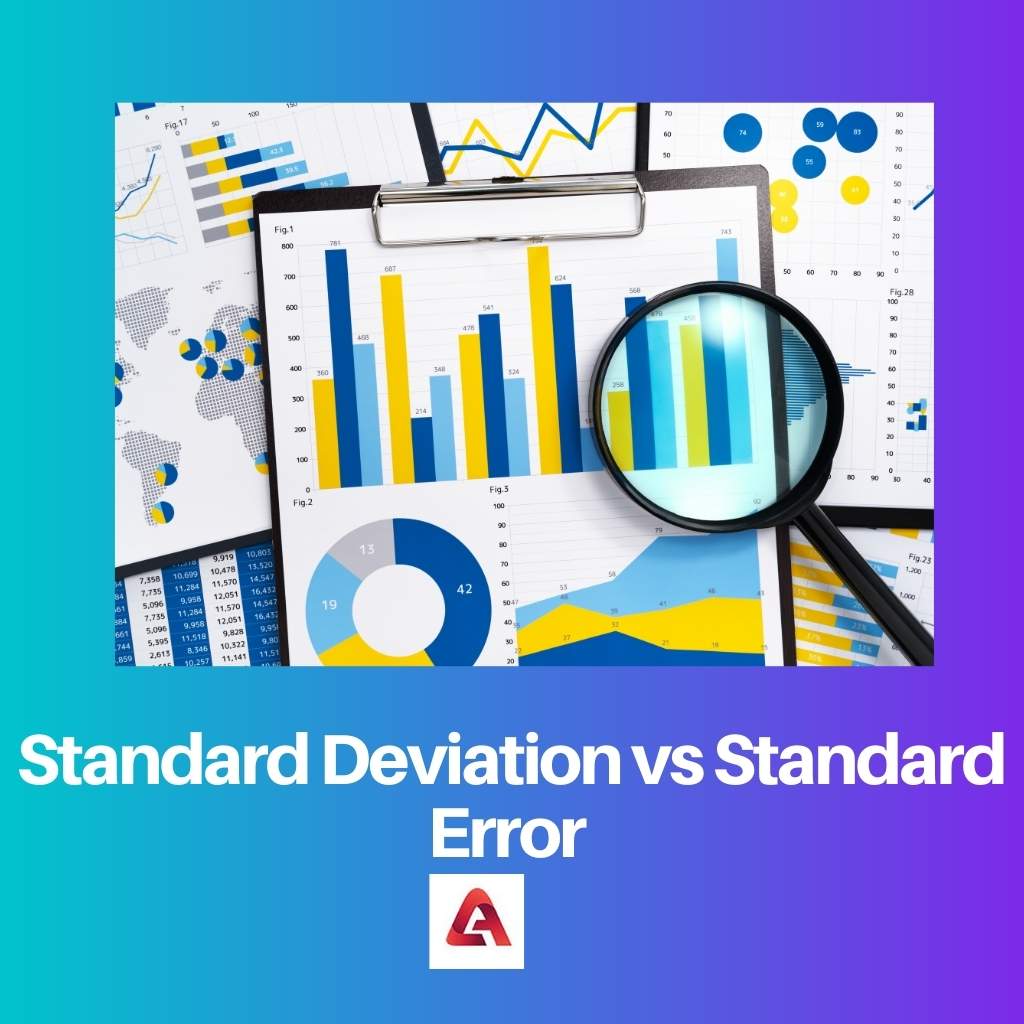The term “statistics” means the practice of analyzing and collecting numerical data which is provided in large quantities. There are several statistical studies, some of which are biology, finance, psychology, engineering, and many more.
Statistical studies are helpful to collect and analyze any data which is in its numerical form.
Standard Deviation and Standard Error are two of the most common measures which are used in the field of statistics. The main motive of Standard Deviation and Standard Error is to show the results of statistical analysis and characteristics of sample data.
Standard Deviation and Standard Error are a bit confusing, but they vary from each other in many terms.
Key Takeaways
- Standard deviation measures the dispersion of data points around the mean, while standard error estimates the variability of a sample mean.
- A larger sample size results in a smaller standard error, but the standard deviation remains unaffected by sample size.
- Standard deviation is appropriate for analyzing individual data points, while standard error is used to assess the accuracy of sample means.
Standard Deviation vs Standard Error
The difference between Standard Deviation and Standard Error is that they both vary in their statistical interferences. Standard Deviation helps individual data values to disperse. It shows the accuracy of the mean, which represents sample data. In contrast, Standard Error is based on statistical interferences of sampling data.

In statistics, Standard Deviation expresses the number of members of a certain group which differs from the value of the mean of the same group. Karl Pearson was the first to use Standard Deviation in writing for his lectures.
This term was first used in 1894. Standard Deviation was the term used for replacing alternative names used earlier for the same ideas.
In statistics, the Standard Error is referred to as the approximate Standard Deviation, which is included in the statistical sample population. The variation included in the Standard Error is between the mean, which is calculated based on population, and the other is accurate, which is accepted.
If the calculation of the mean includes more data points, then the standard error will be smaller.
Comparison Table
| Parameters of Comparison | Standard Deviation | Standard Error |
|---|---|---|
| Meaning | A measure of the dispersion from the mean through a set of data. | A measure of an estimate through its statistical exactness. |
| Denotes variability | Within the sample. | In population, among multiple samples. |
| Type | Descriptive statistics. | Inferential statistics. |
| Distribution | The observation is concerned with the normal curve. | An estimate is concerned with the normal curve. |
| Calculation | By square rooting the variance. | Dividing Standard Deviation by square roots of sample size. |
What is Standard Deviation?
Variation indicates the deviation of values that are at the average. As a result, the degree of variation is designated by measures of variation. In terms of measures of variation, Standard Deviation is one of the most common measures used.
For convenient mathematical analysis, people prefer Standard Deviation as it is completely based on all the values whether it is the highest one or lowest.
Standard Deviation is referred to as the measure of the dispersion from the mean through a set of data. Its main motive is to measure the absolute variability of any distribution.
If the dispersion or variability is higher than the Standard Deviation is too greater. As a result, the magnitude of the deviation will also be greater. Standard Deviation is denoted by σ (sigma).
When it comes to financial terms, the Standard Deviation is used in deals such as mutual funds, stocks, and others. Standard Deviation is used to measure risks that are related to an investment instrument.
It is helpful for investors because it provides them with the mathematical basis to make decisions in the financial market for their investments.
The Standard Deviation can be calculated by software that is used for statistical analysis as well as by hand. For the final result, you have to go through a few steps, such as finding the mean and then, from it finding each score’s deviation.
Further square deviation and find the sum of squares. Then go for variance and find it, later, find the square root of it.

What is Standard Error?
In mathematics, Standard Error is used to measure variability in statistics. SE is its abbreviated form. It helps to make an approximation of Standard Error in a given sample.
It estimates the accuracy, consistency, and efficiency of a sample, or it can be said that it measures how to present a sampling distribution that represents a population in a precise way.
Mean, or average, is calculated when there is a sampled population. Standard Error helps to make up for any incidental inaccuracies linked to the gathering of the samples.
When multiple samples are collected, it creates a difference among the variables as the mean of each sample slightly varies from each other. The difference is calculated as the Standard Error.
Standard Error is useful in terms of statistics as well as in economics. When it comes to financial terms, it is helpful in the field related to econometrics. In this researcher used Standard Error to perform hypothesis testing and regression analysis.
Whereas in inferential statistics, Standard Error is the basis for the creation of confidence inter.
Standard Error is calculated by dividing Standard Deviation by the square root of the sample size. If there are more data points in the mean calculation, the Standard Error will be smaller.
As a result, the data will be more representative of the true mean. In case notable irregularities are found in data, it means that Standard Error is large.

Main Differences Between Standard Deviation and Standard Error
- Standard Deviation does not rely on random sampling because, from the average, it is the typical deviation. But Standard Error depends on random sampling because, from the expected value, it is the typical deviation.
- In terms of the increase in sample size, Stanard Deviation gives a specific measure of it. On the other hand, in Standard Error, it decreases.
- Standard Deviation is mentioned as sample statistics because its statistics include values that are derived from the sample. While Standard Error is mentioned as a population parameter in which parameter is a value and describes the entire population.
- Standard Deviation measures the number of observations that vary from each other, whereas Standard Error measures the accuracy of the sample mean to the population mean.
- When it comes to the calculation of the confidence interval related to the population, Standard Deviation does not calculate through it. On the flip side, Standard Error does.
- https://www.sciencedirect.com/science/article/pii/S0022103113000668
- https://www.jstor.org/stable/2729411
Last Updated : 08 August, 2023


Emma Smith holds an MA degree in English from Irvine Valley College. She has been a Journalist since 2002, writing articles on the English language, Sports, and Law. Read more about me on her bio page.

It’s fascinating to see how standard deviation and standard error can provide so much insight into statistical analysis. The emphasis on their differences was particularly insightful.
I agree, the clear distinction between standard deviation and standard error made this article a valuable read for anyone interested in statistical methods.
Absolutely, I appreciate how the article delved deep into the practical application of each measure. It really helps to solidify the understanding of these concepts.
This article is a comprehensive guide for anyone trying to understand standard deviation and standard error. The historical context provided was also very interesting.
Fantastic article! I really appreciate the detailed explanation of both standard deviation and standard error.
Indeed, it’s quite informative. I also found it interesting to learn about the different uses of these measures in different fields.
Absolutely, the examples provided from finance and investments really helped in understanding the practical application of standard deviation.
The comparison table was particularly helpful in understanding the differences between standard deviation and standard error. It’s refreshing to see such clarity in statistical explanations.
Definitely, the detailed breakdown of their meanings, types, and calculations was very helpful in understanding these statistical measures.
I completely agree, the comparison table was a great addition. It made the distinctions much clearer.
The focus on the uses of standard deviation and standard error in various fields provides a comprehensive understanding of how these measures are applied. A great read!
Absolutely, the article’s insights into different fields added depth to the overall understanding of these concepts.
I agree, the real-world applications highlighted the practical significance of these statistical measures.
The historical context and the evolution of the terms ‘Standard Deviation’ and ‘Standard Error’ added depth to the article. It’s always great to understand the origins of statistical measures.
I completely agree, it’s fascinating to look into the origins of these foundational statistical measures.
The practical implications of standard deviation and standard error in financial contexts were enlightening. I found the explanations very thorough and easy to understand.
I completely agree, the article’s clarity in explaining their relevance in finance was commendable.
Absolutely, the financial applications brought a real-world perspective to the importance of these concepts.
This article provides a brilliant overview of how standard deviation and standard error are used in different contexts. It’s incredibly insightful.
This is an excellent source for understanding the nuances of standard deviation and standard error. The detailed breakdown of their meanings and implications is truly valuable.
Absolutely, the article provides a comprehensive understanding of these statistical measures. The practical applications were particularly enlightening.
The article does an excellent job of making complex statistical concepts accessible. The explanations are clear and the examples are very illustrative.
Absolutely, the clarity in the explanations makes it easier to grasp these statistical concepts.